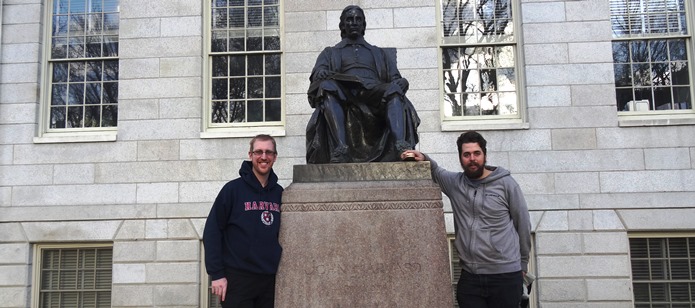News
3D printing bone tissue
Jun 28 2022
Two University of Wollongong students are on the trip of a lifetime, to showcase their 3D printing research at the world-famous Harvard University.

While other 20-something travelers are living out of a backpack, Shannon and Reece don’t travel light. They arrived in Massachusetts with a highly specialised 3D-printer packed in their luggage along with their winter woolies, their aim; to share their 3D printing expertise with their Harvard colleagues.
The printer is a custom-made (by the ACES crew) extrusion printer that can print two different materials at the same time, either by mixing them together on the fly, or layering them on top of each other. The printer is especially suited to printing soft materials – much like natural tissue.
It’s this kind of know-how that the Harvard crew are interested in.
“The guys over here at Harvard have been making some really tough and strong hydrogels, but they have never printed them,” Reece said.
“So we’ve come over to show them how to print the materials, and to get some great samples with interesting structures out of it.”
The trip came about thanks to Shannon and Reece’s supervisor Professor Marc in het Panhuis, who met with Harvard Professors at a conference and told them about the students’ work.
“As it turned out,” Shannon said, “they were keen to get into 3D printing and I guess they were impressed with some of our work and were kind enough to invite us to Harvard for three months.”
At home, Shannon and Reece work on 3D-printing tough hydrogels (soft materials made mostly from water), for use in medical bionics and soft robotics. Their research will contribute to creating a soft, highly dexterous 3D robotic hand.
“One of the aims of the trip is for us to get a better understanding of the materials that they are making at Harvard,” Shannon said.
“Combined with our understanding of 3D printers and hydrogels, we can plan future projects that our groups can work on together, using our array of printers at UOW.”
Recently, Shannon has published research about using tough hydrogels in 4D printing, where researchers print shape-shifting objects that transform into different shapes according to stimuli like heat or water.
Shannon and Reece’s trip is jointly funded by ACES, Professor Marc in het Panhuis, Professor Geoff Spinks and the UOW Science, Medicine and Health faculty. Resources were provided by Australian National Fabrication Facility.
Pictured: Reece Gately (on left) and Shannon Bakarich at the Harvard University Statue













